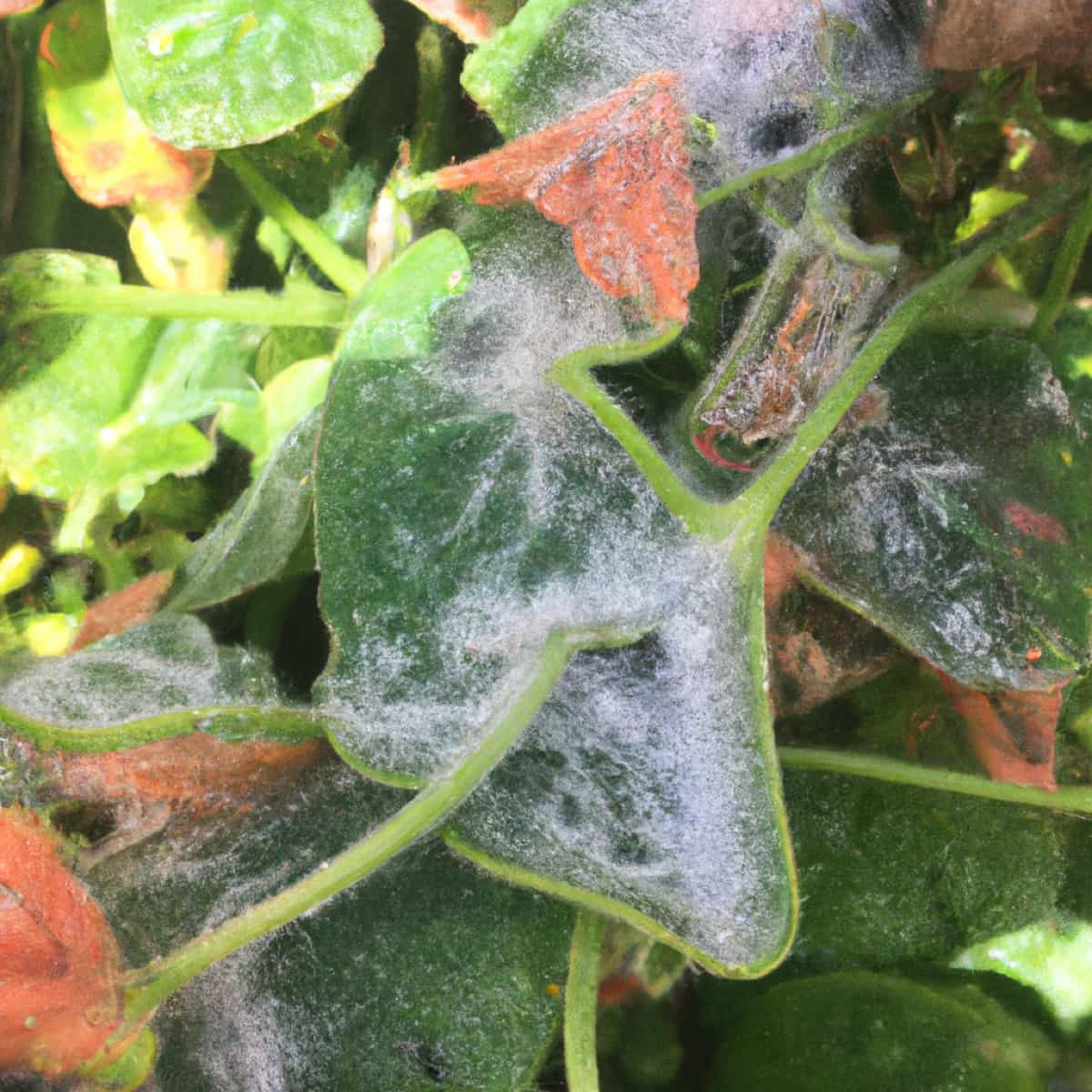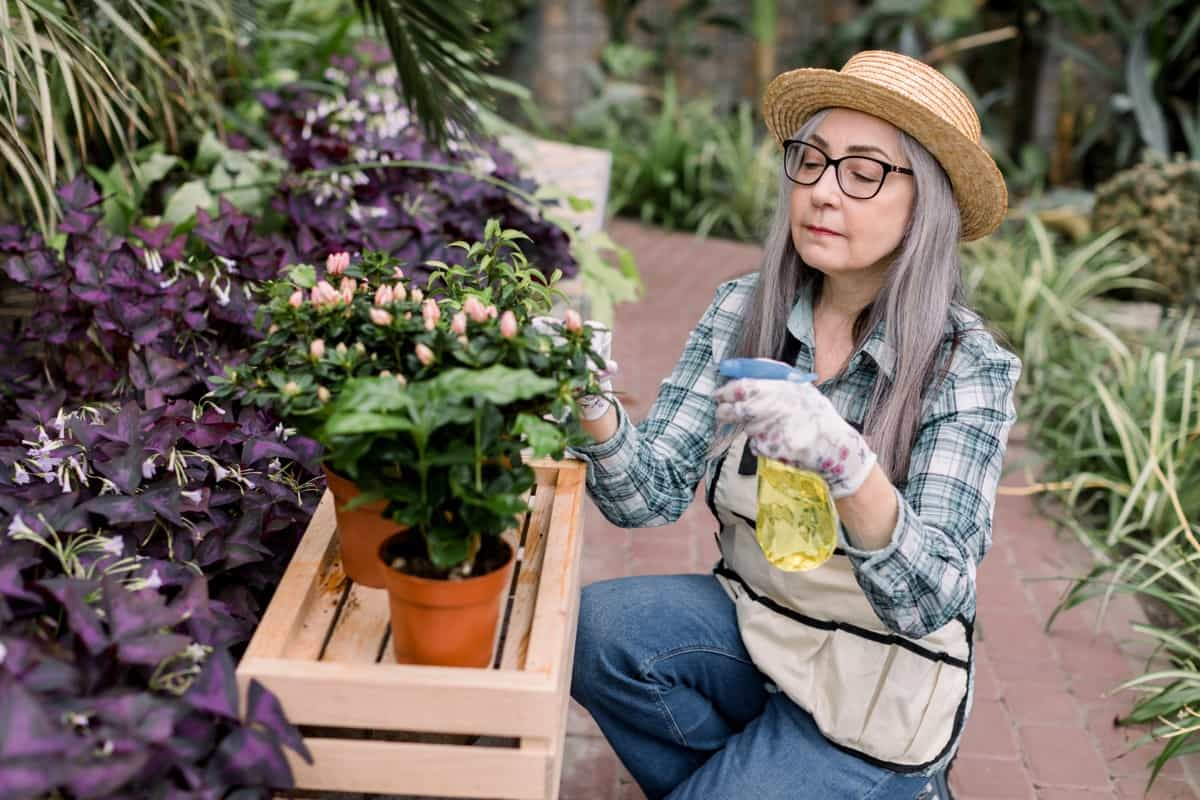Powdery mildew disease is a fungal disease affecting many garden plants, trees, and shrubs. It appears as a powdery white or grey substance on infected plants’ leaves, stems, flowers, and fruit. The fungus responsible for powdery mildew thrives in warm and humid environments but can survive in cooler temperatures. This common fungal disease affects many types of plants and can quickly spread if not treated properly.

How to Treat Powdery Mildew in Plants
Causes of Powdery Mildew
- It is a fungal disease that affects plants, causing them to develop a powdery white or grayish coating on their leaves and stems. If left untreated, this can lead to stunted growth, reduced yields, and even plant death.
- Several factors can contribute to the development of powdery mildew in plants. One of the main causes is high humidity levels combined with warm temperatures – this provides an ideal environment for spores to thrive. Poor air circulation around plants can also contribute to the spread of the disease.
- Additionally, certain species of plants are more susceptible to powdery mildew than others. For example, roses and cucumbers are known to be particularly vulnerable.
- The fungus spores are easily spread by wind or water droplets to healthy plants nearby. Powdery mildew does not discriminate between indoor or outdoor plants; it can infect everything from roses to tomatoes.
- Another factor contributing to powdery mildew is soil pH imbalance – when soil pH is too alkaline or acidic, it disrupts nutrient uptake in plants, making them more susceptible.
- Stress caused by environmental factors like drought or overwatering can weaken a plant’s immune system making it more vulnerable. Gardeners and farmers must understand these causes to take preventative measures against future outbreaks.
Symptoms of Powdery Mildew
- It affects many plant types, including vegetables, fruits, and flowers. One of the first signs that your plant may have powdery mildew is the appearance of white or grayish-white powder on its leaves.
- As the disease progresses, you may notice that the affected leaves become distorted or discolored. They may turn yellow or brown and eventually die off. In severe cases, powdery mildew can cause defoliation, weakening your plant’s ability to photosynthesize and produce fruit.
- Another symptom of powdery mildew is stunted growth. Infected plants often fail to thrive because they are unable to absorb some nutrients from the soil effectively. Some varieties of powdery mildew can also create small black dots on infected areas.
Natural or Homemade Powdery Mildew Remedies Without Harmful Chemicals
- One effective natural remedy for powdery mildew is milk. The proteins in milk act as antifungal agents that can kill the spores responsible for the disease. Mix about 1 part milk with 9 parts water to use this treatment and spray directly onto the affected leaves.
- Another organic solution for treating powdery mildew is baking soda. Mix baking soda (2 tablespoons) with water (1 gallon) and add dish soap (a few drops) to help it stick to the plant leaves. Spray this mixture on your plants every 7-10 days until symptoms disappear.
- Garlic also has antifungal properties, making it an effective natural remedy for powdery mildew. Crush a few garlic cloves, steep them in boiling water overnight, then strain out the cloves before spraying directly onto affected areas.
- Neem oil is another great option for combating powdery mildew naturally without harmful chemicals. Dilute neem oil with water according to package instructions and apply using a spray bottle directly onto infected leaves.
In case you missed it: Minnesota Vegetable Gardening: Calendar and Planting Guide

Precautions to Control Powdery Mildew in Plants
- Ensure the affected leaves and stems are clean and dry before application. This will ensure the remedy can stick better without interference from dust or moisture.
- Next, use a spray bottle or pump sprayer to apply the solution evenly onto all plant parts, including both sides of the leaves and stems. Be careful not to miss any spots, as this could spread powdery mildew.
- It is important not to over-saturate the plant with too much liquid, as this could cause damage or even kill it. A light misting is usually enough for effective treatment.
- After applying the solution, leave it on for at least 24 hours before rinsing it with water if necessary. Repeat this process every few days until all signs of powdery mildew have disappeared.
- Remember that prevention is key to avoiding future outbreaks of powdery mildew. Regularly inspect your garden plants for early signs of infection and consider using preventative measures such as increasing air circulation around plants and reducing humidity levels indoors or in greenhouses.
Tips for Applying Homemade and Organic Sprays
- Apply the spray evenly over both sides of the leaves.
- Reapply after rain or heavy dew.
- Test any new treatment on a small part of your plant first before treating the entire plant.
- Store your homemade solutions properly in labeled containers away from children and pets.
Organic Powdery Mildew Treatments for Healthier Plants
- It is a common disease that affects many plants and can quickly spread if left untreated. Fortunately, several organic treatments are available to help combat powdery mildew while promoting healthier plant growth.
- One effective treatment is using compost tea. This mixture of water and compost provides the plant with essential nutrients while introducing beneficial microorganisms that help fight off powdery mildew.
- Another option is neem oil, which comes from the seeds of the neem tree. Neem oil has antifungal properties that work well against powdery mildew without harming beneficial insects or pollinators.
- Baking soda mixed with some water can also be used as an organic treatment for powdery mildew. The alkalinity of baking soda disrupts the cell walls of powdery mildew spores, preventing them from growing and spreading on your plants.
- Vinegar is also an effective fungicide when mixed with water in equal parts. It helps lower the pH levels on plant surfaces that inhibit fungal growth but must not exceed two teaspoons per gallon of water, or it could burn your plants.
- Additionally, garlic or onion sprays can be made by soaking chopped garlic or onions in water overnight and then straining out the bits before spraying them onto affected plants. These sprays contain sulfur compounds that can inhibit fungal growth.
- Milk is an effective organic treatment for powdery mildew due to its antiseptic properties. Mix 1 part milk with two parts water and spray directly on infected leaves once a week until symptoms disappear. These organic treatments provide safe alternatives to chemical fungicides while effectively treating powdery mildew and promoting healthy plant growth.
How to Treat Powdery Mildew Naturally with Homemade Solutions?
Using these homemade and organic remedies, you can effectively treat powdery mildew without harmful chemicals. Whether you use ingredients from your kitchen or make a spray with natural oils, plenty of options will help keep your plants healthy and free from this common fungal disease. Remember always to identify the symptoms of powdery mildew early on so that you can begin treatment as soon as possible. With a little effort, you can create a thriving garden resistant to powdery mildew and other pests while keeping it safe for humans and animals alike.
In case you missed it: Plant Spacing Chart for Vegetables, Fruits, Flowers, and Herbs

Conclusion
Identifying powdery mildew early is important so treatment can begin promptly. By doing so, you’ll be able to prevent further spread of the infection while saving your infected plant from permanent damage. Plants with powdery mildew may experience stunted growth, yellowing leaves, and premature leaf drop. If left untreated, the disease can weaken the plant’s immune system making it more susceptible to other diseases and pests.
- Feed Your Flock for Less: Top 10 Tips to Save on Chicken Feed
- Ultimate Guide to Ossabaw Island Hog: Breeding, Raising, Diet, and Care
- Hatching Answers: The Top 10 Reasons Your Chickens Aren’t Laying Eggs
- Eggs and Economics: Breaking Down the Cost of Raising Backyard Chickens
- Defend Your Greens: Proven Methods to Keep Iguanas Out of Your Garden
- Ultimate Guide to Cinnamon Queen Chicken: A Comprehensive Guide for Beginners
- Ultimate Guide to California Tan Chicken: Breeding, Raising, Diet, Egg-Production and Care
- Ultimate Guide to Marsh Daisy Chicken: Breeding, Raising, Diet, and Care
- 10 Types of Chicken Farming Businesses You Can Start for Profits